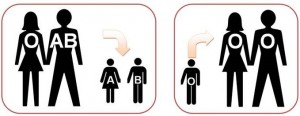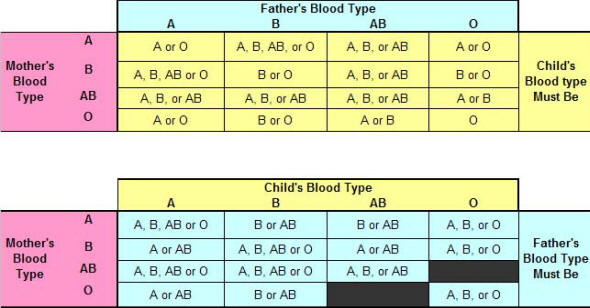A paternity test requires DNA samples of those affected. What happens when this is not possible, when one participant is missing or does not wish to participate in the test? Could you prove potential paternity by looking at blood types?
 Our blood type is inherited from both our parents, just as we inherit physical characteristics such as skin color or hair. Blood group depend on the paternity blood typeexpression of an ABO gene located on chromosome 9, A, B, AB or O.
Our blood type is inherited from both our parents, just as we inherit physical characteristics such as skin color or hair. Blood group depend on the paternity blood typeexpression of an ABO gene located on chromosome 9, A, B, AB or O.
Human beings have two pairs of each chromosome, each parent having provided. Our genotype is comprised of two possible expressions of this gene, which gives the following possible combinations AA, AB, AB, AO, BO, OO.
The A and B genes are dominant (they are always expressed) and the O gene is recessive (it is only expressed in the presence of a second gene O).
The ABO blood type charts below can be used to predict the possibilities of paternity.
You can determine either:
1. The ABO blood type of the child when the blood type of the father and the mother are known, or
2. The ABO blood type of the father if the blood type of the child and the mother are known (bottom chart).
ABO blood types may be complex to understand. This really is mainly because of the truth that the ‘O-type’ antigen is masked by the presence of an A- or B-type antigen. This is explained in the following chart, displaying the various the genotypes that make up the blood types.
| Genotype (DNA) | Blood Type |
| AO or AA | A blood type |
| AB | AB blood type |
| BO or BB | B blood type |
| OO | O blood type |
For example, two O blood type parents can produce a kid with only O blood type. Two parents with a blood type can create a child with either A or O blood types. Two parents with B blood type can produce a child with either B or O blood type. 1 parent having a and an additional with B can produce a kid having a, B, AB or O blood types. If one parent has a and another has AB, they can either produce a kid with a, B or AB blood types. If 1 parent features a and an additional has O, they can either produce a child with a or O blood kinds.
Rh Positive (Rh+) and Negative (Rh-) Blood types.
The Rh (+/-) factor is inherited separately from the ABO blood types. Similarly to the masking effect from the O gene in ABO blood kinds, the Rh negative (Rh-) gene can also be masked by the presence of a Rh good (Rh+) genotype. Therefore, an individual may have a Rh + blood kind and can nonetheless have an Rh – gene (See the chart beneath). Moreover, two parents with Rh + blood types can have a kid with Rh – blood type.
Genotype (DNA) | Blood Type |
| (+ , -) or (+ , +) | Rh + |
| (- , -) | Rh – |

